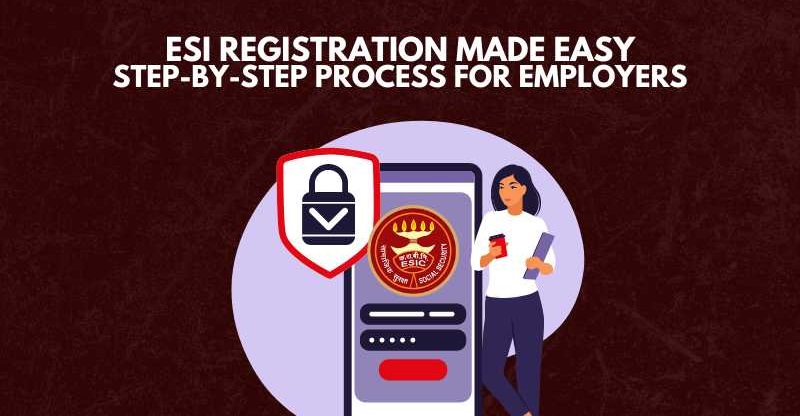Introduction
The Employee State Insurance (ESI) scheme provides essential social security benefits to Indian workers. Employers are required to register their establishments with the Employee State Insurance Corporation (ESIC) to ensure compliance. This article explains the ESI registration process, the required documents, and the compliance obligations.
What is ESI, and Why is Registration Important?
The Employee State Insurance (ESI) scheme, governed by the Employee State Insurance Corporation (ESIC), is designed to offer employees medical, financial, and social security benefits. Registration under this scheme is mandatory for establishments that meet certain eligibility criteria. Failure to register can result in penalties and legal consequences.
Eligibility Criteria for Businesses Under ESI
Businesses need to register under ESI if they meet the following conditions:
- Number of Employees: Establishments with more than 10 employees (in some states, 20 employees) must register.
- Employee Wages: The ESI scheme covers employees with a maximum salary of Rs21,000 (Rs25,000 for employees with disabilities).
- Industry Type: Applicable to factories, shops, hotels, restaurants, cinemas, educational institutions, and more.
Step-by-Step ESI Registration Process:
- Log in to the ESIC Portal:
- Visit the ESIC website and click on the ‘Employer Login’ option.
- Sign up by entering the required details, such as the employer’s name, email, and mobile number.
- Confirmation Mail:
- Once signed up, the employer will receive a confirmation email containing the username and password to access the portal.
- Fill the Employer Registration Form (Form-1):
- Log in to the ESIC portal using the credentials provided.
- Click on ‘New Employer Registration’ and select the type of establishment (factory, shop, etc.).
- Fill in details of the unit, employer, factory/establishment, and employees in ESI Form-1.
- Payment of Initial Contribution:
- After submitting Form-1, the system will generate a payment challan for the advance contribution.
- Pay six months of advance contributions through the online portal.
- Receive Registration Letter (C-11):
- Upon successful payment, the ESIC will issue a Registration Letter (C-11) containing the establishment’s unique 17-digit registration number. This letter serves as proof of registration.
Documents Required for ESI Registration:
While the ESI registration process is online, the following documents are needed during the application process:
- Registration Certificate under the Factories Act or Shops and Establishment Act.
- Certificate of Incorporation (for companies), Partnership Deed (for partnerships).
- GST Registration Certificate.
- PAN Card of the business and employees.
- Employee details, including wage information.
- Address proof of the establishment (utility bills, rental agreement, or property tax receipt).
- Cancelled cheque for the business account.
- List of directors and shareholders (for companies).
Benefits of ESI for Employers and Employees
The ESI scheme offers a wide range of benefits to both employers and employees:
- Medical Benefits: Employees and their families are entitled to free medical treatment.
- Sickness Benefits: 70% of wages are provided during certified sickness for up to 91 days annually.
- Maternity Benefits: Full wages are provided to female employees for 26 weeks during maternity leave.
- Disability Benefits: Employees receive 90% of wages in case of temporary or permanent disability.
- Funeral Expenses: Rs15,000 is provided to the dependents to cover funeral costs in case of death due to employment injury.
Post-Registration Compliance
Once registered, the employer must follow these post-registration compliance requirements:
- Maintain Registers: Employers must keep registers about employee attendance, wages, and accidents.
- Monthly Returns and Contributions: File monthly returns and pay contributions to the ESIC within 15 days of the following month.
- Accident Register: Maintain a record of workplace accidents for reporting and claim purposes.
Conclusion
The ESI registration process is essential for businesses that meet the eligibility criteria. It ensures compliance with labor laws and provides employees with valuable social security benefits. Following the step-by-step process and ensuring proper documentation can help businesses complete the registration without hassle. For assistance with ESI registration and compliance, contact Anil D’Souza & Associates (ADCA) at +91 7303414760.
FAQ
Is ESI registration mandatory for employers?
Yes, ESI registration is mandatory for all employers with more than 10 (or 20 in some states) employees earning up to Rs21,000 per month.
What is the penalty for not paying ESIC contributions on time?
Employers who fail to pay contributions are subject to a 12% interest penalty per annum on the delayed payment.
Can an establishment exit the ESI scheme if the employee count drops below 10?
No, once registered, an establishment remains covered under the ESI Act, even if the employee count drops below the threshold.
How can an employee check their ESI registration details?
Employees can check their registration details using their insurance number by logging into the ESIC portal’s ‘Insured Person Login.’
What is the ESI code number?
The ESI code number is a unique 17-digit identification number allotted to an employer after registration.






1 thought on “Step-by-Step ESI Registration Process for Employers”
Hi, this is a comment.
To get started with moderating, editing, and deleting comments, please visit the Comments screen in the dashboard.
Commenter avatars come from Gravatar.